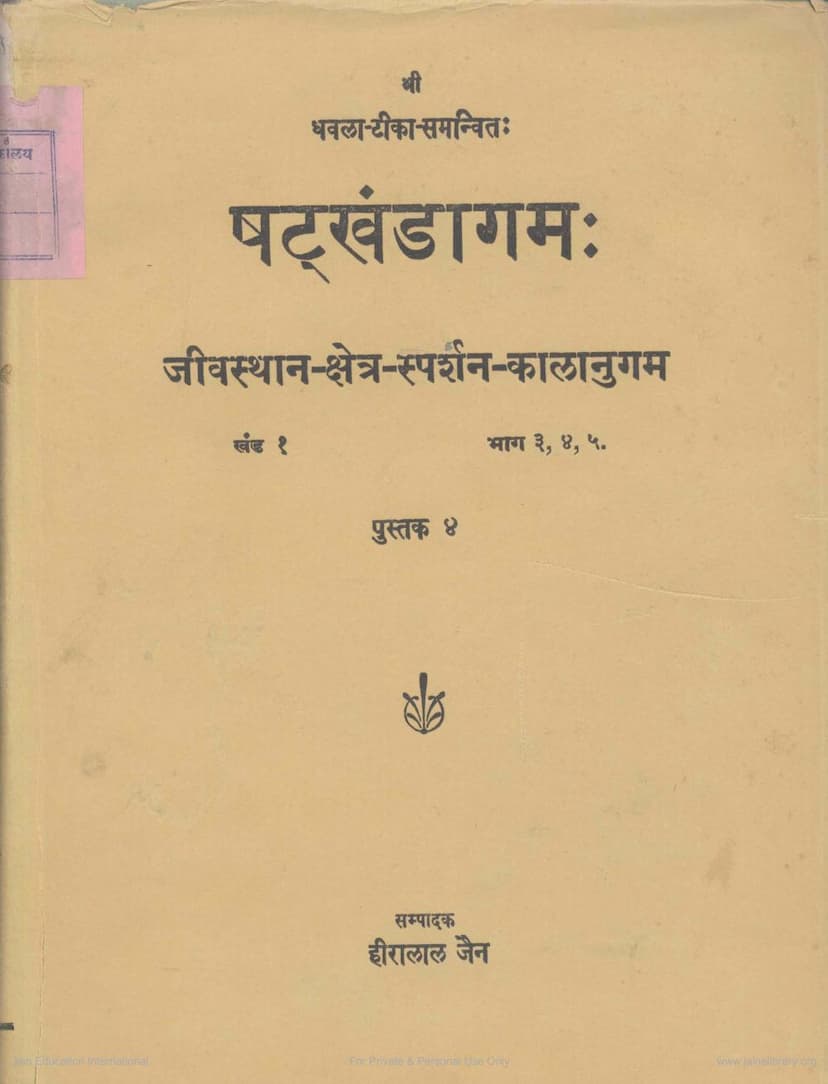Shatkhandagama Pustak 04
Added to library: September 2, 2025

Summary
This is a comprehensive summary of the Jain text, Shatkhandagama Pustak 04, focusing on the sections covering Kshetra-sparsana-kalanugama (Space, Touch, and Time Analysis). The text is the fourth volume of the Shatkhandagama, with the Dhavala commentary, and was compiled and edited by Hiralal Jain and others.
Here's a breakdown of the key aspects covered in this volume, based on the provided pages:
I. Overall Context and Significance:
- Shatkhandagama: This is a foundational Jain scripture attributed to Pushpadanta and Bhutabali, with commentary by Virasena. It's part of the "Six Divisions" (Shatkhanda) of Jain doctrine.
- Volume IV Focus: This particular volume delves into the Jiva Sthana (States of the Soul) and specifically covers the Kshetra (Space occupied), Sparshana (Space touched), and Kala (Time spent) aspects of souls in different spiritual stages (Gunasthanas) and life conditions (Marganas).
- Editorial Efforts: The publication highlights extensive editorial work, including Hindi translation, comparative notes, mathematical explanations, and indexes, making this ancient text accessible to modern readers.
- Importance: The text is crucial for understanding Jain cosmology, metaphysics, and the intricate calculations related to the existence and movement of souls within the universe. It also touches upon the evolution of mathematics in ancient India, particularly within the Jain tradition.
II. Key Concepts and Content:
-
Kshetra (Space):
- The Universe (Loka): The text describes the structure of the Jain universe (Lokakasha), differentiating it from Alokakasha (void space). It discusses two main views on the universe's shape: one as three conical frusta and another as three pyramidal frusta with a rectangular base. The latter view, which leads to a universe of 14 rajju height and 343 cubic rajju volume, is adopted.
- Spatial Units: The primary unit of measurement is the Rajju, a vast, immeasurable length unit in Jain cosmology. The text details how smaller units are derived.
- Soul's Spatial Presence: It explains how souls occupy space based on:
- Svasthana: Their usual place of habitation.
- Samudghata: Expansion of their substance beyond the usual volume due to various causes like pain (Vedana), passion (Kashaya), transformation (Vikriya), or spiritual attainment (Kevali-samudghata).
- Upapada: Their movement and placement in a new birth.
- Detailed Calculations: The text provides intricate geometrical and mathematical calculations to determine the spatial extent occupied by souls in different Gunasthanas and Marganas, considering these various conditions. This includes calculations for specific areas like the "conch field" (Shankha Kshetra), "bee field" (Gomzhi Kshetra), etc.
- Illustrations: The volume includes numerous diagrams to visually represent the spatial configurations of the universe and the areas occupied by beings, which were created based on wooden models.
-
Sparshana (Touch/Contact):
- Time Dimension: Unlike Kshetra, which focuses on the present, Sparshana considers the spatial contact of beings from the past, present, and future.
- Volume of Space Touched: The text calculates the volume of space that beings of different spiritual stages and life conditions happen to touch over time.
- Celestial Calculations: It involves detailed mathematical exercises related to the number and arrangement of celestial bodies (sun, moon, stars) to determine spatial touch.
- Luminaries: The text provides detailed information about the number of luminaries (suns, moons, planets, stars) in various parts of the universe. For instance, it mentions that in the region of the Jambudvipa, there are two suns and two moons, and elaborates on their numbers in subsequent islands and seas, leading to complex mathematical calculations.
-
Kala (Time):
- Periods of Time: This section deals with the minimum and maximum durations souls spend in various spiritual stages and life conditions.
- Units of Time: It mentions units like Samaya (instant), Avali (a very short period containing innumerable samayas), breath (Prana), Muhurta (48 minutes), days, months, years, Yuga, and eventually Palyopama and Sagaropama (vast units of time).
- Vast Time Cycles: The text describes extremely long time cycles like Utsarpini and Avasarpini, which constitute a Kalpa (a cosmic time cycle), and ultimately Pudgala Parivartana (an extremely long duration related to the transformation of matter).
- Mathematical Concepts: The volume includes a significant contribution from Dr. A. N. Singh (likely Avadhesh Narayan Singh) on the "Mathematics of Dhavala," discussing early Indian mathematics, the place-value system, big numbers, indices, and even logarithms (referred to as 'Ardhaccheda'). The classification of infinity (Ananta) into eleven types is also a notable aspect.
III. Contentious Issues Discussed:
- Right to Study Siddhanta: The introductory section addresses a debate regarding whether lay Jains have the right to study the Siddhanta texts. The editor strongly refutes the notion that such study is prohibited for householders, citing ancient authoritative texts and the authors' own intentions.
- Universality of Knowledge: The commentary emphasizes that the scriptures, including the Dhavala, were intended for the benefit of all beings, regardless of their intelligence or status.
IV. Key Mathematical and Cosmological Concepts:
- Rajju: The fundamental unit of spatial measurement.
- Lokakasha: The inhabited universe.
- Samudghata: The expansion of soul-substance.
- Vargasamvargita (Law of Indices): Early concepts of exponents.
- Ardhaccheda (Logarithm): The text presents concepts that are precursors to logarithms.
- Ananta (Infinity): The classification and understanding of infinity.
In essence, Shatkhandagama Pustak 04 is a scholarly work that meticulously analyzes the spatial, tactile, and temporal existence of souls according to Jain philosophy, supported by intricate mathematical frameworks and detailed cosmological descriptions. It serves as a vital source for both spiritual and intellectual understanding of Jain teachings.